Siding is made from different materials, but in all categories there are panels with imitation of a bar. Such facade cladding is always popular due to the combination of the type of natural wood with the strength and durability of artificially made panels. Siding under the timber for outdoor decoration is superior in quality to natural material, it is difficult to distinguish it from the natural finish layer already a meter away from the wall.
Types of siding with imitation of a bar for outdoor decoration
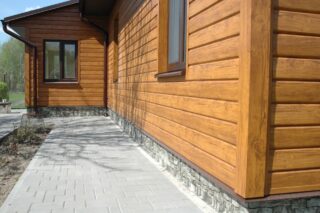
The type of material and color of the panels are selected taking into account the purpose of the finish. For the decoration of outbuildings, garages, hangars, inexpensive varieties are used, and a residential building is faced with expensive and high-quality siding. The durable material is based on a layer that resists moisture, temperature differences, frost and other harmful atmospheric factors.
For finishing, siding panels are produced to imitate timber:
- made of wood;
- with vinyl, acrylic base;
- made of metal;
- combined from fibers and cement.
Products differ in the method of production, the type of initial raw materials, and working properties. Some of them are light, others weigh enough so that it is necessary to strengthen the foundation for them, to make a strong frame.
Inexpensive include vinyl siding, the average price for fiber cement and wood material, and metal panels are more expensive depending on the type of polymer coating and its thickness.
Wood
Pressed siding made from fine fibers from the woodworking industry is produced under pressure at high temperatures. Include synthetic binder resins, add crushed polypropylene particles.
Properties of modern wood siding:
- almost does not absorb water, this quality is obtained by the material during heat and moisture treatment during the production process;
- the ignition temperature is significantly increased in comparison with natural material;
- panels are made of wood with a moisture content of not more than 18%;
- the remains from the processing of hard species, for example, oak, larch, are allowed into production;
- the panels are impregnated with antiseptic under pressure.
Block-house siding under the timber is produced with different methods of joining. The panels are connected in a quarter, a groove-comb is used, they are assembled with an overlap, they are combined end-to-end. As the top layer, paint and varnish compositions are used, which reliably protect the strips from delamination and destruction. The finishing will last up to 15 years, while the clarity of the pattern and the colors of the cladding will not change.
Vinyl
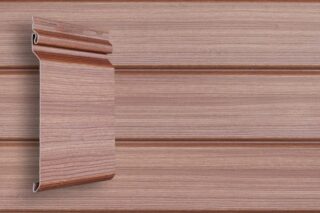
The composition includes about 80% of polyvinyl chloride, in the manufacture of mixed particles of vinyl, binding ingredients and modifying additives. Strips come in one or two layers, which are glued together to increase strength. Quality panels are painted not only on the outside, but also on the inside.
Advantages of vinyl wood imitator:
- lightweight material does not exert additional force on the wall and base of the house;
- easy to process and install on the facade;
- duration of operation without loss of quality - 12 - 15 years;
- completely repels water, harmful microbes and mold do not develop on it;
- can be used with a temperature difference of -50 ° - + 60 ° С;
- does not accumulate dust, just washes.
Timber imitation vinyl siding, especially at a budget price, should not be installed in direct sunlight. The color will fade, fade. If a damaged board needs to be replaced, all subsequent strips will need to be disassembled.
Metal
Panels with a base in the form of an iron sheet are used for wall cladding, since they are durable and reliable. The metal is galvanized in an electrolyte solution, then a polymer protective film is applied to the outer and reverse sides. The color of the coating is different, it is chosen according to the RAL catalog, where all color samples are brought to a single standard.
Coatings are made that have a different chemical composition:
- acrylic 25 microns thick;
- polyvinyl chloride (plastisol) 200 microns thick;
- polyester - 25 microns;
- pural - 50 microns;
- polydifluorionate PDP - 50 - 80 microns.
Depending on the thickness of the protective film, it is possible to make a relief embossing with a grain pattern, which adds realism to the texture.
Metal siding options for cladding a house under a bar show moisture resistance, strength, and are easy to clean. The colored surface does not fade.
Fiber cement
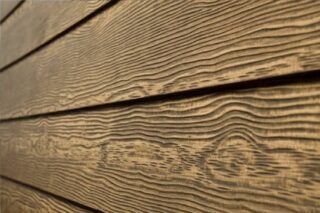
For production, water, Portland cement, sand, mineral fibers and pigments are mixed. Previously used asbestos threads, but they are recognized as harmful to health. Modern panels are produced with artificial fillers. Fiber cement products have an attractive appearance, imitate different materials, including wooden beams. Gray slabs are hardly ever produced.
Product technical indicators:
- material thickness 7 - 12 mm, width up to 20 cm, product weighs 12 - 16 kg;
- absorbs water up to 20% of the mass;
- shows no deformation during 20 freezing and thawing cycles;
- lasts about 50 years, but after 12 - 15 years, painting is needed.
The lack of a large weight of the material. Fiber cement with wood fibers is produced, but this is not placed on the facade due to its high saturation with moisture.
Benefits of timber siding
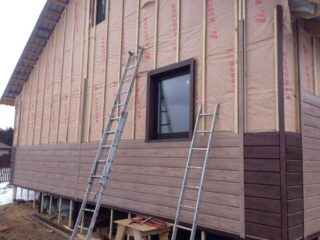
This type of cladding is installed as a curtain wall when a support frame is needed. Inside the lathing, it is possible to insert insulation, waterproofing, wind film in order to additionally protect the building.
Material advantages:
- you can sheathe buildings with walls made of any material;
- initial characteristics hardly change during work in street conditions;
- siding is easy to care for, clean;
- these are ready-to-install products.
The lathing for siding hides the irregularities of the facade, so there is no need to additionally level it with plaster. Installation takes place quickly, because they do not wait for the setting of the solution, the set of strength. The installation can be done with your own hands.
Dimensions of metal siding
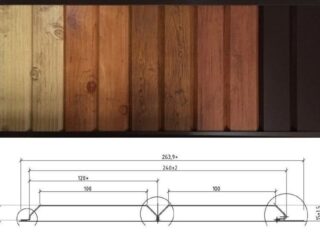
You need to know the dimensions of the strips in order to calculate the required amount of material. The sizes are given in the catalogs of the manufacturers, they can also be obtained from the suppliers of the goods. If you use averaged dimensions rather than being accurate for a particular model, the material may not be sufficient or will need to be returned.
Parameters of metal siding for timber:
- products with imitation of a bar are not wide, like the lumber itself - a range of 12 - 25 cm, there is a composite profile, where several rows of a bar fit on one panel, their width is about 550 cm;
- the length is 3.66 or 3.05 meters;
- the thickness of the profile is taken according to the size of the inner metal, the protective films are not taken into account - 0.45 - 1.1 mm;
- the strip weighs from 6 to 12 kg.
The parameters are directly proportional to each other. If the width, thickness, increases, the weight of the strip increases.
Installation features
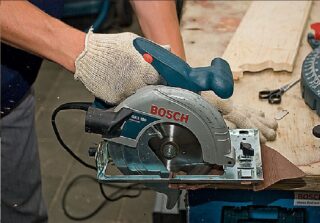
To cut siding, take a hand hacksaw for iron, scissors for steel or a circular saw with an appropriate disc. It is impossible to use a grinder, since the protection melts at the cut site, and the flying sparks melt points on the surface.
Step-by-step installation procedure:
- Facade preparation, crack jointing.
- Layout and installation of the lathing with a simultaneous hinge of insulation, film.
- The starting bar is mounted first at the bottom of the frame racks, the bottom of the first siding panel is inserted into it.
- The board is pulled up, snapped in until it stops, the upper edge is fastened to the rack with self-tapping screws.
- The panel is fixed, starting from the center, then moving to the edges.
- Self-tapping screws are placed in the center of the hole to provide the siding with the ability to expand and contract when temperatures change; for the same reason, hardware is not screwed into depth by 3 - 4 mm.
The following strips are similarly snapped in and fixed to the crate. Before installing the last panel, a finish bar is placed at the top. The top of the board is brought into it, if necessary, it is cut to the width.
The windows are framed with special additional strips, and decorative overhead corners are used on the inner and outer corners.
Choosing between imitation and natural wood
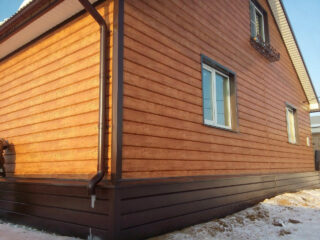
The main difference between the artificial material is its resistance to moisture. Natural wood absorbs water from the atmosphere, soil (basement siding), gets wet in the rain. As a result, the geometry of the finishing layer changes, it swells and warps or dries up, cracks appear in the seams.
Siding panels made of any material undergo appropriate processing, therefore they do not react at all to water or absorb it in small volumes, which does not affect the appearance and integrity of the cladding. The durability of natural timber depends on the operating conditions. Artificial lasts longer, does not collapse, bugs and rot do not spoil it.
Cost matters. Natural material is expensive, especially hard rocks, while synthetic ones are more expensive. The appearance of the cladding does not suffer from this, since the drawing is very realistic.








